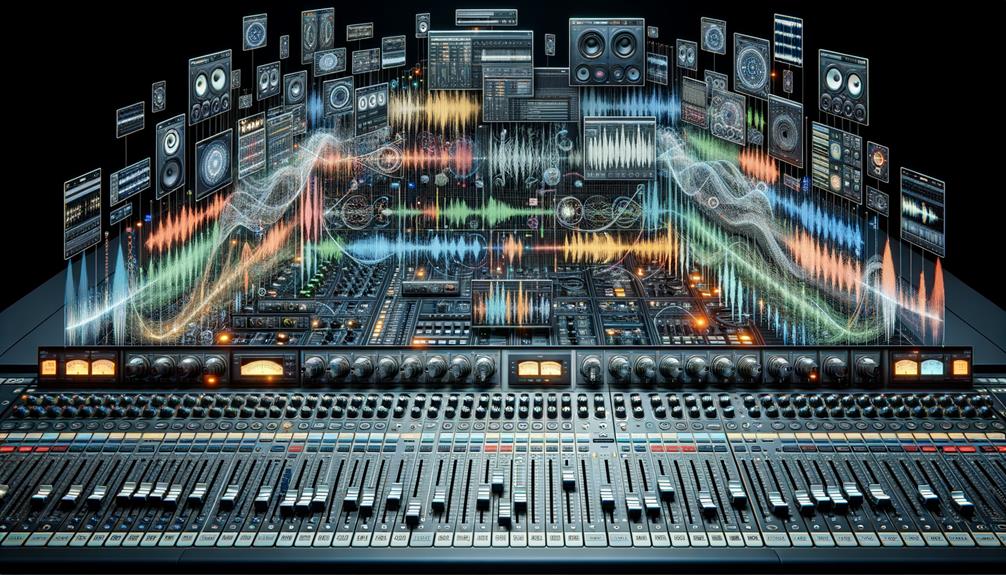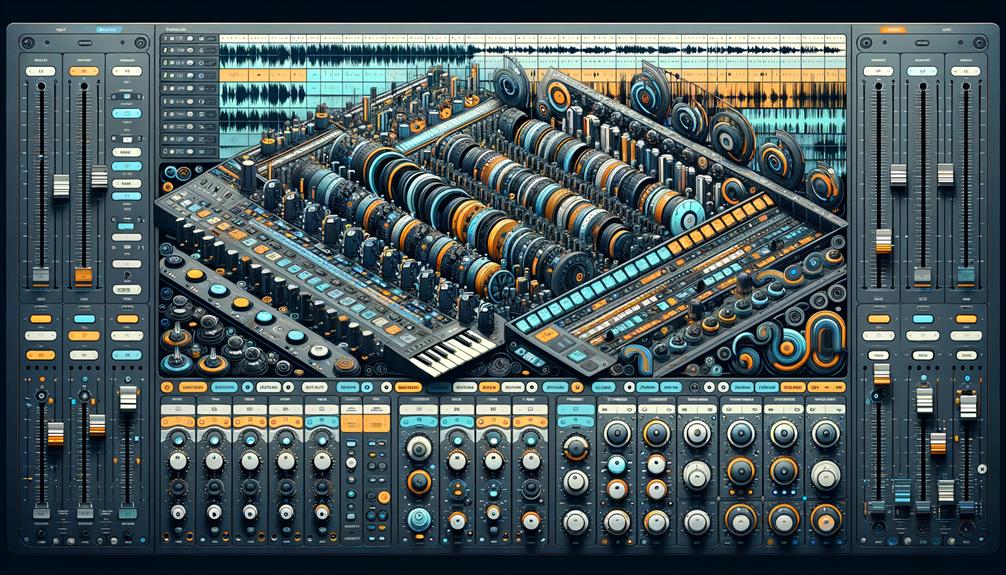No products in the cart.
When diving into the world of mixing Dolby Atmos in Logic Pro X, it’s like embarking on a sonic journey with endless possibilities.
You’ll find yourself navigating through the intricate pathways of spatial audio tools, configuring surround formats, and crafting immersive soundscapes that transport your listeners into the heart of your music.
Each step holds the key to unlocking a new dimension of audio production, and as you venture further, you’ll uncover the essential techniques that bring your mix to life in Dolby Atmos.
So, let’s unravel the intricacies of mixing in this revolutionary format and discover the art of sculpting three-dimensional sonic experiences that captivate and mesmerize.
Contents
hide
Key Takeaways
- Configuring project settings, including sample rate, I/O buffer size, and surround format, is crucial for setting up a Dolby Atmos mix in Logic Pro X.
- Utilizing spatial audio tools and plugins within Logic Pro X can enhance the immersive experience of a Dolby Atmos mix.
- Creating immersive soundscapes involves leveraging surround panning, higher sample rates, and optimizing for the Atmos Renderer.
- Mixing techniques for Dolby Atmos require attention to sample rate, I/O buffer size, project frame rate, and exporting in ADM BWF format for seamless distribution.
Setting Up Your Project
To set up your project for Dolby Atmos mixing in Logic Pro X, configure the sample rate, I/O buffer size, and surround format according to the specific requirements for immersive audio production.
Start by creating a new project in Logic Pro and ensure that the sample rate is set to either 48 kHz or 96 kHz, as these are the native sample rates supported by Dolby Atmos. For optimal performance, adjust the I/O buffer size to a minimum of 512 samples for 44.1 kHz or 48 kHz projects, and 1024 samples for 88.2 kHz or 96 kHz projects.
When setting up your project, it’s essential to consider the surround format. By default, Logic Pro sets the project surround format to 7.1.2 for Dolby Atmos projects, but you have the flexibility to change it to 5.1 or 7.1 in the project settings according to your specific mixing requirements.
Additionally, when mixing in Dolby Atmos, it’s crucial to configure the Output settings in Logic Pro for a dedicated immersive speaker setup. This ensures that the audio is accurately distributed across the various channels, providing an immersive listening experience for your audience.
Configuring Spatial Audio Tools
You can configure the spatial audio tools in Logic Pro X by accessing the plugin interface and adjusting the parameters to create immersive and dynamic soundscapes. To ensure an optimal setup for mixing in Dolby Atmos, consider the following:
- Sample Rate: When working on a Dolby Atmos project, it’s essential to choose the appropriate sample rate of 48 kHz or 96 kHz. Logic Pro X handles real-time conversion, but keep in mind that this may impact performance based on the project’s complexity and your computer’s processing power.
- I/O Buffer Size: Set the I/O buffer size according to the project’s sample rate. For 48 kHz projects, a minimum of 512 samples is recommended, whereas for 96 kHz projects, it should be set to 1024 samples to ensure smooth playback and processing.
- Surround Format: By default, Logic Pro X sets the project surround format to 7.1.2 for Dolby Atmos projects. However, you have the flexibility to adjust this setting to 5.1 or 7.1 in the project settings to align with your specific creative requirements.
To delve deeper into these spatial audio tools and their configurations, refer to the Logic Pro X Pro User Guide for comprehensive guidance on Atmos mixing and spatial audio.
Utilizing Surround Format

When working on Dolby Atmos projects in Logic Pro X, the surround format, which determines the available output channels and surround bed, can be adjusted in the project settings to align with your specific creative requirements. Logic Pro offers the flexibility to configure output settings for a dedicated immersive speaker setup, allowing you to fully utilize the spatial capabilities of Dolby Atmos. By understanding and utilizing the surround format, you can optimize the spatial audio experience for your audience.
| Dolby Atmos Projects | Logic Pro Surround | Sample Rate | Surround Bed |
|---|---|---|---|
| Flexibility to adapt | Configurable | Adjustable | Optimizable |
Ensuring that the project sample rate and surround plug-in settings are appropriately configured is crucial when working with Dolby Atmos in Logic Pro. This attention to detail will allow you to create immersive and spatially dynamic audio mixes. Additionally, utilizing the surround panner within Logic Pro will enable you to precisely position audio elements within the surround sound field, further enhancing the immersive experience for your audience. Embracing the surround format in Logic Pro empowers you to deliver innovative and captivating Dolby Atmos mixes that push the boundaries of spatial audio.
Creating Immersive Soundscapes
Embracing the surround format’s configurability in Logic Pro X allows for the creation of immersive soundscapes that fully exploit the spatial capabilities of Dolby Atmos.
To create truly immersive soundscapes, follow these steps:
- Leverage Surround Panning: Explore the surround panning capabilities in Logic Pro X to precisely position audio elements within the three-dimensional space. Experiment with the placement of sounds to envelop the listener and create a sense of depth and movement within the mix.
- Utilize Higher Sample Rates: Increasing the sample rate of your project settings can enhance the clarity and precision of the audio, resulting in a more immersive listening experience. Consider using higher sample rates, such as 96kHz or 192kHz, to capture more detail and subtle nuances in your soundscapes.
- Optimize for the Atmos Renderer: Familiarize yourself with the Dolby Atmos Renderer within Logic Pro X to ensure that your soundscapes are optimized for playback in the Dolby Atmos format. Understanding the specific requirements of the Atmos Renderer will enable you to fine-tune your mix for maximum immersive impact.
Mixing Techniques for Dolby Atmos


Utilize Logic Pro X’s built-in Dolby Atmos Renderer for an immersive and precise mixing experience.
When mixing in Dolby Atmos, it’s crucial to understand the specific techniques that can elevate your project.
Start by ensuring that your project’s sample rate aligns with Dolby Atmos standards, which support native rates of 48 kHz and 96 kHz.
For sample rates of 44.1 kHz or 48 kHz, set the I/O buffer size to a minimum of 512 samples to optimize performance.
Additionally, remember that the required frame rate for a Dolby Atmos music mix is 24 fps, so configure your project accordingly.
Logic Pro typically defaults to a surround format of 7.1.2 when creating a Dolby Atmos project, providing a solid foundation for your mixing endeavors.
Throughout the process, pay close attention to the master channel and level meters to ensure that your mix adheres to Dolby Atmos specifications.
Lastly, when exporting your project, keep in mind that Dolby Atmos projects typically use the ADM BWF format, so make sure to select this option for a seamless transition from mixing to distribution.
Frequently Asked Questions
Can You Mix Dolby Atmos in Logic?
Yes, you can mix Dolby Atmos in Logic Pro. It offers Dolby Atmos compatibility, advanced audio plugins, surround sound capabilities, and flexible speaker setup options. You’ll experience an immersive audio engineering experience with innovative mixing techniques and sound design, including customizable panning options for an immersive experience.
How Do You Automate Dolby Atmos in Logic?
To automate Dolby Atmos in Logic Pro, explore advanced automation techniques for surround sound and spatial audio. Experiment with innovative audio panning, mixing techniques, and spatial effects to create an immersive experience, mastering 3D audio for cutting-edge sound design.
How Is Dolby Atmos Mixed?
Dolby Atmos basics involve surround sound, spatial audio, and immersive experience. You mix using advanced audio processing, mixing techniques, and sound design in Logic Pro X. Utilize professional tools and optimize your studio setup for top-notch music production.
How Do I Export Dolby Atmos Mix From Logic?
To export a Dolby Atmos mix from Logic Pro X, ensure your project is set up for Dolby Atmos workflow. Use the appropriate audio formats, apply mastering tips, and verify your room calibration and monitoring setup for accurate spatial audio.
Conclusion
So, now you know how to mix Dolby Atmos in Logic Pro X.
By following the right settings and configurations, you can create immersive and spatial audio experiences for your projects.
Don’t forget to pay attention to sample rates, I/O buffer sizes, frame rates, and surround formats to ensure a seamless Dolby Atmos mix.
Get ready to elevate your audio mixes to the next level with these techniques!




